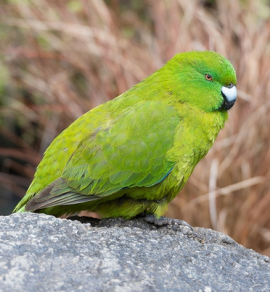Antipodes Green Parakeet |
|
|
Also known as: Antipodes Parakeet, Antipodes Island Parakeet, Antipodes Unicolor Parakeet, Uniform Parakeet
Photos
View in GalleryDid You Know?
The main diet of the Antipodes Green Parakeet is leaves, which are chewed; piles of chewed foliage still attached to the stem of the plant are a sign of feeding.Academic Research
Related publications: Cyanoramphus unicolorSpecies Profile
Genus: Cyanoramphus | Species: unicolor
Size:
30cm (11.7 in)
Weight:
130g
Subspecies including nominate:
one
Colour Adult:
Both adults olive/green plumage; bright emerald green crown and face; breast and abdomen more yellowish; outer web of flight feathers blue; green tail, edged with green/yellow. Bill silver/grey with dark grey tip. Eye orange/red.
Colour Juvenile:
As in adults but with shorter tail. Bill pink/white in youngsters. Eye pale brown.
Call:
Described as resonant and penetrating - kok-kok-kok-kok. Similar to calls of other Cyanoramphus sp. but much deeper in tone. Also soft chattering.
Listen NowVideo Links:
Video 1 | Video 2More Information:
Content Sources:
CITES
BirdLife International
New Zealand Birds Online
Cornell Lab of Ornithology/Birds of the World
Parrots: A Guide to Parrots of the World, Juniper and Parr, 1998.
Parrots of the World, Forshaw and Cooper, 1977. 2010 edition
Parrots of the World, Forshaw, 2006.
Lexicon of Parrots, Thomas Arndt.
Parrots in Aviculture, Low, 1992.
Parrots: Survey Status and Conservation Plan 2000-2004, Snyder, McGowan, Gilardi and Grajal, 2000.
Photos
View in GalleryDid You Know?
The main diet of the Antipodes Green Parakeet is leaves, which are chewed; piles of chewed foliage still attached to the stem of the plant are a sign of feeding.Academic Research
Related publications: Cyanoramphus unicolorSpecies Care
Captive Status:
Apparently not kept outside of New Zealand.
Longevity:
Not recorded.
Housing:
3.5 x 1 x 2m (11.5 x 3.3 x 6.5 ft) enclosure.
Diet:
Green leaves such as: Swiss chard, dandelion, chickweed, lettuce, sowthistle; small seed mix such as: hemp, millet, canary seed; limited sprouted sunflower seed; fruit such as: apple, pear, banana, cactus fruits, oranges; vegetables such as: carrot, celery, green beans, peas in pod, corn on cob; small amounts of clean mealworms; vitamin and mineral supplements; commercial kibble if taken.
Enrichment:
Provide with unsprayed flowering branches with buds, provide bowl for bathing. If possible, soil for digging.
Nest Box Size:
Not recorded.
Clutch Size:
2-5
Incubation Time:
24-28 days
Fledging Age:
39-42 days
Hatch Weight:
Not recorded.
Peak Weight:
Not recorded.
Weaning Weight:
Not recorded.
Photos
View in GalleryDid You Know?
The main diet of the Antipodes Green Parakeet is leaves, which are chewed; piles of chewed foliage still attached to the stem of the plant are a sign of feeding.Academic Research
Related publications: Cyanoramphus unicolorSpecies Wild Status
World Population:
About 2100.
IUCN Red List Status:
Vulnerable
CITES Listing:
Appendix II
Threat Summary:
A BirdLife “restricted-range” species. The main threat to this species is the accidental introduction of a mammalian predator; although once a remote possibility, increased fishing pressure around the Antipodes has greatly increased the chances of such an event.
Range:
Found on Antipodes Islands, New Zealand.
Habitat:
Is found in dense tall Poa littorosa tussock grasslands, open scrub and Carex sedge. Also in areas of prickly fern and Coprosma antipoda scrub. Commonest on steeper slopes and near water.
Wild Diet:
Eats Poa and Carex leaves, seeds, berries, flowers and the carrion of dead penguins and petrels and the eggs of seabirds.
Ecology and Behaviour:
Are found singly or in small groups. Feed mainly in morning and before dusk. Birds very tame and inquisitive. Birds bathe in pools and roost in burrows.
Clutch and Egg Size:
2-5 nearly spherical eggs, 26.0 x 23.0mm (1.01 x 0.89 in)
Breeding Season:
October-January. Nest is in a well-drained burrow, excavated in peat moss beneath vegetation or in the bases of tall tussock grass.
Related Links:
Photos
View in GalleryDid You Know?
The main diet of the Antipodes Green Parakeet is leaves, which are chewed; piles of chewed foliage still attached to the stem of the plant are a sign of feeding.Academic Research
Related publications: Cyanoramphus unicolorMembers Only Resources
Please log-in now to find more research, resources and tools.
Not a Member?
Find more great information:
Gain exclusive access to 600+ pages of additional research, seminars and podcasts, specialists to ask your toughest questions, and dozens of other fun resources - when you become a WPT member.
Join Today >>

































